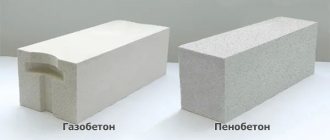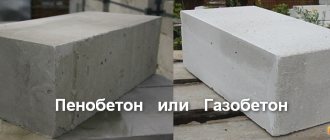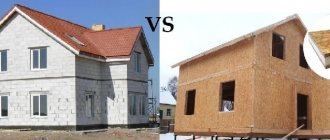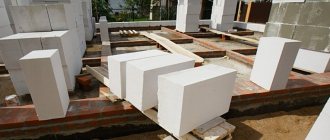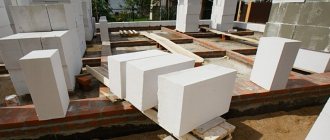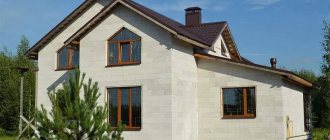The lack of natural gas in many suburbs and cottage villages has a particularly acute effect during the heating season, when you have to pay literally exorbitant prices for every kilowatt of thermal energy. But owning your own home also has its benefits. One of them is that a low-rise building can be made as warm as desired by using structural and thermal insulation materials – cellular concrete blocks – when constructing walls. They are made from foam concrete and aerated concrete, but let’s try to figure out what is the difference between them and which is better.
Blocks made of aerated concrete and foam concrete Source adscore.ru
Classification
These two types of lightweight concrete only have the same classification. The difference between foam concrete and aerated concrete lies in the density and type of material, although in regulatory documents the thermal conductivity of foam concrete and aerated concrete at the same density is considered equal.
Thus, the lightest foam concrete blocks with a density of up to 500 kg/m³ are classified as thermal insulation. And for aerated concrete, blocks with a density of up to 400 kg/m³ are considered thermal insulating.
Aerated concrete blocks with a density of 500-900 kg/m³ are considered structural and thermal insulation and serve as building materials for self-supporting walls without reinforcement. And when laying armored belts in every fourth row, they can be used to build load-bearing walls of low-rise buildings. For foam concrete, these include blocks with a density of 600-1000 kg/m³.
Foam concrete and aerated concrete blocks with a density above 1000/1100 kg/m³ are classified as structural.
For reference! Due to the optimal strength/thermal insulation ratio, the most popular blocks are D500 and D600 (the number indicates density).
A clear difference between blocks of different densities, using aerated concrete as an example Source acost.ru
But density and thermal conductivity are the only indicators that closely coincide for these two similar, but still different materials. And the differences between them lie at the level of composition and production technology. Therefore, to choose aerated concrete or foam concrete, which is better, you need to carefully study all the properties of both materials and the conditions of their use.
Shapes and sizes of blocks for building a house
The height of the blocks remains unchanged - 250 mm. The width can vary from 100 to 400 mm as needed. The length is usually 600 or 625 mm. The main size range includes the following varieties:
- 100×300×600 – single;
- 200×300×600 – double;
- 150×300×600 – one and a half.
Regarding the shape, aerated concrete and foam concrete are made in the form of classic wall and partition blocks. There are also specialized models - for example, U-shaped blocks.
Both materials considered are popular and in demand. When making the final choice of which is better in your case, aerated concrete or foam concrete, you can rely on reviews from customers who used these materials to build a house. It is also worth asking construction experts for their opinion on the optimal choice.
Production technology
If we consider the structure of both types of cellular concrete, we can see that even here there are differences between them. With the same density, foam concrete visually has a greater spread of cell sizes from the smallest to the largest, and aerated concrete is more uniform. This difference in structure is determined by the way the cells are formed, but this is not the only difference between aerated concrete and foam concrete.
Foam concrete production
The composition of foam concrete is classic concrete with Portland cement binder and sand filler. Moreover, filler is added only for medium and high density foam concrete, starting with grade D500. The cellular structure is obtained by mixing the prepared concrete mixture with a foaming agent or ready-made foam. This is what distinguishes the two main manufacturing methods: classical and barotechnology.
Kit for the production of foam concrete using barotechnology Source chrome-effect.ru
Pressure technology involves adding a foaming agent directly to the mixture without using a foam generator. Usually these are mobile installations that allow you to produce foam concrete directly on site. Their productivity is low, but quite sufficient to provide building materials for the construction of a low-rise building. The disadvantage of the technology is the increased consumption of foaming agent and slightly lower strength of foam concrete compared to classical technology.
The classic technology is a little more complicated - the same prepared concrete mixture is used, but it is mixed with ready-made foam, which is obtained in a foam generator from a foam concentrate and water. The production process looks like this:
- sand is poured into the concrete mixer first (to “bind” the remaining water from the previous portion);
- add cement and water, mix until smooth;
- a portion of foam is prepared separately in a foam generator (in accordance with the required density of foam concrete);
- add foam to the concrete mixer and mix for 3-5 minutes;
- liquid foam concrete is transported through a flexible hose into a mold or formwork.
Classic scheme for the production of foam concrete Source nuxiqel.ketadilo.ru.net
See also: Catalog of house projects made from aerated concrete and foam concrete blocks
The general advantages of foam concrete production include:
- simple production technology;
- inexpensive equipment, including “mobile” equipment, which can be installed on site;
- possibility of laying in formwork for monolithic construction of walls;
- variety of ways to make blocks.
Three types of equipment are used to make building blocks from foam concrete:
- pouring into special molds, followed by stripping;
- pouring into cassette molds;
- pouring into a massive mold, followed by cutting into blocks.
Stripping, removal from cassettes and cutting occurs after the initial hardening of the mixture. When modifiers and fiber are added, this period is reduced to several hours. But the manufacturing process does not stop there - the foam blocks still have to “ripen”. It is untimely demoulding and incomplete ripening that can affect the final quality of foam concrete blocks. For example, insufficient exposure after manufacturing and before installation can lead to shrinkage of the blocks as part of the wall, and the use of waste to lubricate the molds can lead to peeling of the front part.
Stripping foam concrete blocks Source nofollow.ru
Production of aerated concrete
In composition and technology, aerated concrete is closer to silicate brick, which is why building blocks made from it are often called “gas silicate”.
A lime-cement mixture is used as a binder, which consists of ¾ of quicklime, crushed to a powder.
The classic filler is quartz sand.
To obtain a cellular structure, a gas-forming agent is used – aluminum paste or powder, consisting of 90% “active” metal.
And, as with any concrete, to “mix” clean (drinking) water is added to the mixture.
The technological process for manufacturing aerated concrete blocks looks like this:
- The sand is washed, water is added and ground to a sludge state so that the particle sizes are comparable to cement and ground lime binder.
- Sand sludge is mixed with binder.
- The gas-forming agent is diluted in water and added to the mixture of sand and binder.
- Mix all the ingredients and pour into the mold.
- After initial maturation is completed, the monolithic gas silicate is removed from the mold and cut into blocks.
Cutting aerated concrete blocks from a monolith Source chrome-effect.ru
- The blocks are placed in an autoclave, where, under the influence of saturated steam, the process of gas formation is completed, active aluminum is bound to the silicate mixture, and the cement stone is hydrophobized.
The output is fully “ripened” aerated concrete blocks, ready for packaging and transportation to the site.
For reference! The production of such blocks is possible only in industrial production conditions. In this case, it is almost impossible to “run into” handicraft products of low quality. This is the main difference between aerated concrete and foam concrete at the technology level.
Main results
Aerated concrete blocks and foam concrete blocks are a type of cellular concrete. They have similar properties and qualities, but there are still fundamental differences between them. Fundamental to the choice are the individual wishes and requirements of the developer for the finished structure, as well as some individual indicators.
Both one and the second material are quite simple to manufacture. Products can be produced in-house without significant costs. It should be borne in mind that the quality of products can seriously suffer due to inexperience.
The process of constructing a building is also not complicated; aerated concrete and foam blocks require strict adherence to technology. This will save you from unwanted consequences.
Advantages/disadvantages of foam concrete and aerated concrete
The general advantages of these two types of cellular concrete look like this:
- The availability and low cost of ingredients determines the relatively low price of building blocks. But with the same density, aerated concrete is 20-30% more expensive than foam concrete (in terms of 1 m³). This is due to high overhead costs - more expensive equipment and higher energy costs for production. And when choosing, you should pay attention that many sellers get confused in the subtleties of defining technologies - quite often aerated concrete blocks are positioned as autoclaved foam concrete.
Autoclave hardening is an industrial technology, and foam concrete is most often produced in mini-enterprises Source lestorg32.ru
- High thermal insulation properties. Each manufacturer indicates its own indicators, which may vary slightly. But foam concrete is more “stable” compared to aerated concrete and its thermal conductivity is not so dependent on the level of humidity in the surrounding air. This is explained by the closed cell structure, lower hygroscopicity and vapor permeability.
- Both materials are lightweight cellular concrete, so the load on the foundation is low.
- Both materials are non-flammable and environmentally friendly.
Having considered what properties foam concrete and aerated concrete have, what is the difference between them, can be interpreted in two ways - each feature has both a positive and a negative side.
The open cell structure of aerated concrete determines high breathability - this indicator is better than that of wood across the grain. But this same ability determines the hygroscopicity of gas silicate blocks - they easily absorb moisture, which leads to moisture in the structure and partial loss of load-bearing and thermal insulation qualities. Therefore, during breaks in construction, walls and partitions must be covered, and after construction is completed, the finishing of the facade must ensure the weathering of excess moisture.
Preservation of a block house for the winter Source proektproekt.com
In foam concrete, most cells have a closed shell. Only in blocks that are cut into solids, the top layer is characterized by an open structure. Therefore, the vapor permeability of foam concrete is almost as low as that of ordinary concrete. This means that the blocks do not have breathable properties, but their water absorption is low. And in this case, the external decoration is more of a decorative rather than protective nature.
In terms of compressive strength, aerated concrete blocks are slightly better than foam concrete blocks. So, with the same density D500, foam concrete from most manufacturers is classified as thermal insulation with strength class B1, and aerated concrete is classified as structural and thermal insulation with class B2.5.
The dimensional accuracy of building blocks is largely influenced by production culture. Gas silicate blocks, obtained by cutting from solid wood, have an absolute match in size and a perfectly flat surface. This allows them to be laid on an adhesive mixture with a minimum joint thickness, which almost completely eliminates heat loss that occurs with conventional masonry techniques. Even better in this regard are walls made of tongue-and-groove aerated concrete blocks, which do not have “through” vertical joints.
Tongue-and-groove form of gas block Source td-germes.ru
Foam concrete blocks produced by casting into molds do not have such precise geometry. And only blocks cut from solid wood are distinguished by their dimensional stability in one batch. In this question, which is better, aerated concrete or foam concrete, the second loses significantly.
What should be the foundation for a structure made of foam blocks or gas blocks?
The main feature of these blocks is porosity, which is also their advantage, since the structure becomes lightweight. But it can also be considered as a disadvantage.
Flaws:
- fragility;
- low compressive strength coefficient;
- For a structure made of foam blocks or gas blocks, a high-quality foundation is required. This will help prevent cracks from appearing in the future.
For a high-quality foundation, it is necessary to take into account the following parameters:
- soil type;
- ground water level;
- frost freezing depth;
- complexity of the entire structure;
- heaving;
- number of floors of the building.
The most popular is the use of a strip foundation or a monolithic reinforced concrete slab.
This is interesting: Types of foundation
Shrinkage
The ability of the material to shrink when drying is associated with the peculiarity of the composition. When constructing buildings using foam products, cracks may appear on the walls, negatively affecting the strength of the building. Shrinkage is an important characteristic, the value of which is:
- for gas-filled composites, which are characterized by increased hardness and are not prone to cracking - 0.5 millimeters per meter of masonry height.
- for foamed materials prone to cracking 1-3 mm per meter of masonry.
The difference in production technologies affects characteristics such as water absorption and frost resistance
Differences in masonry
Which material is easier to install? Gas-filled composites are installed with glue, unlike foamed ones, which are fixed with cement mortar. Aerated concrete blocks have high accuracy of geometric parameters, the deviation of which does not exceed 3 millimeters. Foam composites have unstable dimensions. Their thickness tolerance is 5 millimeters. The industrial method of producing gas blocks ensures stability of the geometry. The laying of products has its own characteristics depending on the deviation of dimensions. In order to fix the foam composite, at least a centimeter layer of cement mortar is required. The gas block is installed on an adhesive base, the layer of which does not exceed 2 millimeters. If we compare the need for a binder composition, then the adhesive mixture for gas-filled products requires 5 times less than the cement mortar for foam concrete.
Aerated concrete is manufactured in factories, which means its linear dimensions are observed more accurately
Having compared the cost of cellular composites and the cost of purchasing glue or preparing cement mortar, we conclude that masonry based on glue will cost significantly less. In addition, the thermal conditions of the room are positively influenced by the absence of cold bridges when installing gas blocks on glue.
